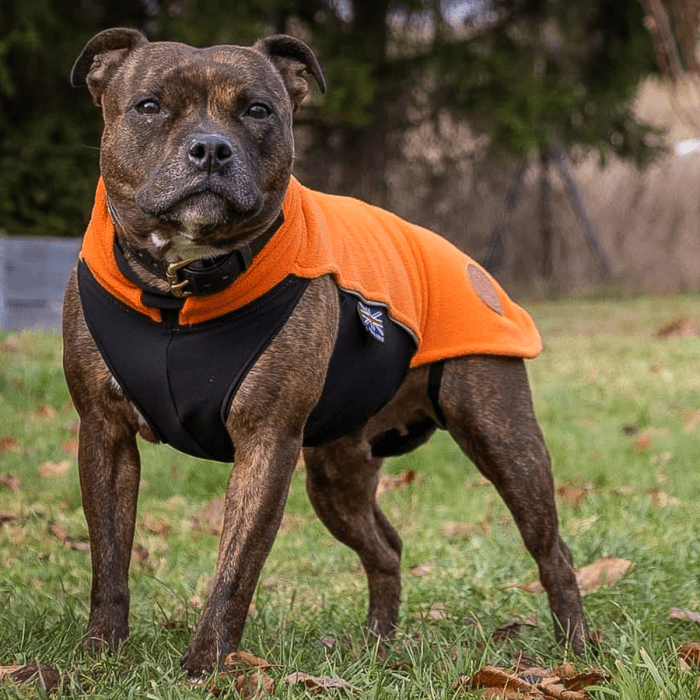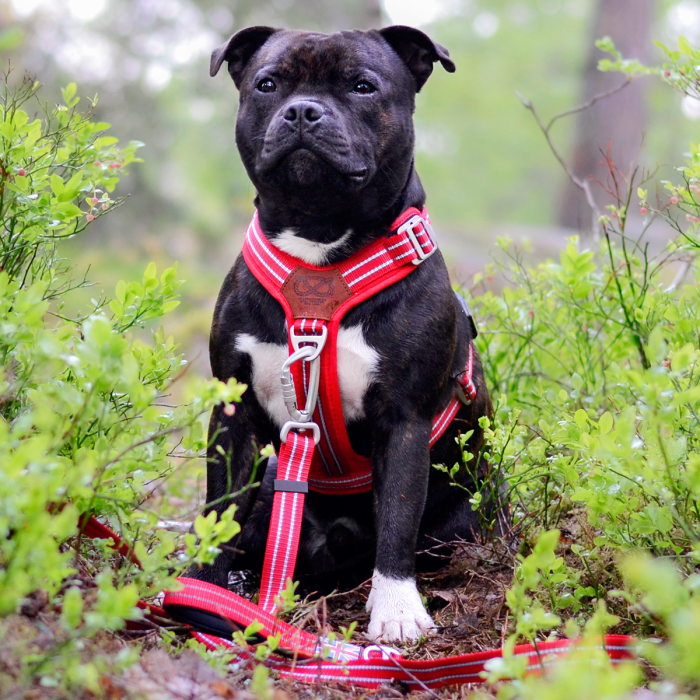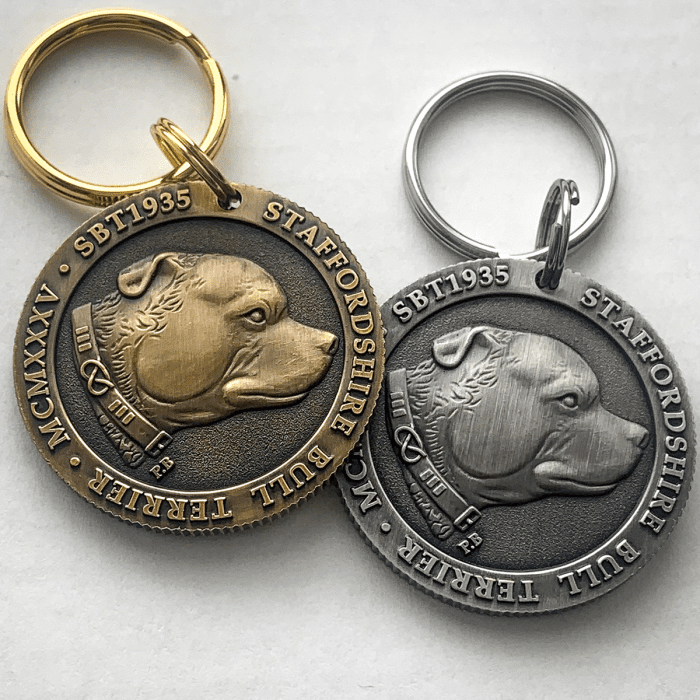General info | Staffordshire Bull Terrier 1935
Below you will see general staffordshire bull terrier breed information that can be important when talking about breeding or if you are getting a staffy and need to ask questions to a potential staffy breeder.
What is COI?
It stands for Inbreeding Coefficient, abbreviated COI and should be as low as possible. The UK Kennel Club breed average COI is 7.6%, see A Beginners Guide to COI for more information.
What is EPS?
It stands for Effective Population Size abbreviated EPS and the Staffordshire Bull Terrier is landing on 97.71. EPS is a measure of how many individuals are contributing genetically to a breed population. It is a measure of the size of the gene pool in a breed. Lower than 100 is considered critical by conservationists and below 50 brings a breed close to extinction. See the Kennel Club article for more information.
Staffordshire Bull Terrier Health and Welfare Problems due to Conformation: (Body shape and physical characteristics) Brachycephalic Obstructive Airway Syndrome (BOAS) due to shortened skull.
BVA/KC Health Schemes: www.bva.co.uk/chs
- Hip dysplasia: breed mean score 12.9 (parents should be lower)
- Elbow dysplasia: score should be as low as possible ideally 0:0
- Eye disease: Hereditary cataract (HC); Persistent hyperplastic primary vitreous (PHPV) (litter screening)
What is EBV?
It stands for Estimated Breeding Values (EBVs) and there are no EBVs currently available for this breed.
www.thekennelclub.org.uk/about-ebvs
DNA Tests Available for Staffordshire Bull Terrier
DogWellNet and IPFD Harmonisation of Genetic Testing for Dogs (HGTD)
- Hereditary Cataract (HC-HSF4)
- Hydroxyglutaric Aciduria (L-2HGA)
- Degenerative Myelopathy (DM)
Availability of a DNA test does not mean that it is always necessary or even desirable for breeders to use this test. Good breeders will have followed the recommendations of the appropriate breed clubs, Kennel Club and/or other qualified experts.
Other Breed-Specific Health Screening Schemes
Litter eye screening for Persistent hyperplastic primary vitreous (PHPV).
Ask the breeder to show you the certificates for the above tests/screening for both parents. If any of the above tests have not been considered necessary by the breeder (and there may be good reasons), ask her to explain why.
Other Diseases Reported
(There are currently no genetic or screening tests for sire or dam)
- Demodicosis
- Atopy
- Hypocobalaminaemia
- Cancer – Mast cell tumour; Neoplasia; Mammary neoplasia; Neoplasia
- L-2-Hydroxyglutaric aciduria
- Cranial cruciate ligament disease (CCL)
- Canine follicular dysplasia
- Cataract
- Corneal ulceration
- Urolithiasis
- Dystocia
- Pyometra
Source: Dog Breed Health
Questions to ask breeder
What with the mass of back yard breeders that have taken an interest in our beloved breed, choosing a legitimate breeder can be a minefield. Here is a list of questions to ask your chosen breeder when visiting a litter, or before being put onto a waiting list. Alongside the questions are what are felt to be suitable answers to look out for, to ensure that you don't let your heart overrule your head when choosing a breeder to buy a puppy from.
How long have you been breeding this breed?
The longer the better!
Do you breed any other breeds?
If more than one, the other breed should have attributes you'd expect the breeder to be interested in. For example; working Labs and working Spaniels shouldn't ring alarm bells.. But a breeder of Staffordshire Bull Terrier's and Poodles should.
What are the negative traits of the breed?
The more that they tell you, the more honest that they are. In Staffordshire Bull Terrier's, of course, possible aggression towards other animals should be discussed honestly and factually. As well as the importance of early socialisation with people and animals, their tendency towards destructive behaviour and the suitable items that they can play with, and suitable training for such a clever and sensitive breed, i.e; positive reinforcement. Staffordshire Bull Terrier's can be strong willed and stubborn, and this must be known before taking in a pup of this breed type.
May I see the father?
He may be a professional stud dog from another breeder, but expect your breeder to at least have a photograph of him and to be able to put you in contact with his owner so that you can find out more about his personality.
Where do the dogs live?
Happy parent dogs live indoors in a home environment. They make the most sociable companions. Ensure to check the garden, some breeders will bring dogs indoors for visits; if there appears to be a shed or kennel outdoors for the dogs, ask questions!
May I look around?
A Conscientious breeders don't mind snoopers!
May I see your other dogs?
They should all be friendly and approachable.
May I return the puppy if there's an unexpected problem?
The best breeders demand that their puppy is returned to them if there's a problem.
May I speak to other people that you have sold puppies to?
Good breeders are confident about the success of their dogs.
Has your vet examined the litter?
The breeder should be willing to give you the name and telephone number of the vet.
Do you participate in vet-supervised health monitoring schemes for the breed?
Good breeders ensure their dogs have been cleared by schemes to monitor inherited conditions such as eye and joint problems. Breeders should have knowledge of the health problems noted below. The COI should also be noted to avoid inbreeding.
Health problems common in Staffordshire Bull Terrier's are:
- Brachycephalic upper airway syndrome (due to facial/skull abnormalities – affects the ability to breathe and causes exercise intolerance)
- Hip dysplasia: breed mean score 12.9 (parents should be lower)
- Cataracts; Persistent hyperplastic primary vitreous (PHPV) (severe lesions can cause visual loss)
- Hereditary cataract (HC-HSF4)
- Organic Aciduria (L-2HGA) (affects the central nervous system from an early age, causing epileptic seizures, wobbliness, and altered behaviour)
- Demodicosis (SKIN PROBLEMS caused by the demodex mite)
- Cancer – Mast cell tumour (cancer of the immune system – ranges from localised tumours in the skin, causing itching and pain, to severe pain and malaise when internal organs are affected)
- Soft tissue carcinoma
- Canine follicular dysplasia (seasonal flank alopecia)
- CDA (colour dilution alopecia - especially in dilute colours such as Blue)
Do you register the results of these health SURVEYS on your breeding stock with the kennel club?
Good breeders are proud of the quality of their breeding stock and register the results. In the most efficient countries, such as Sweden, the registration of test results isn't voluntary, it's a compulsory condition of puppy registration.
How often do you breed from the mother?
Good breeders follow kennel club regulations and limit the number of litters a mother can have, often to no more than four in a lifetime.
Source: Staffy Bull Terrier Forum
STAFFY FACTS | STAFFORDSHIRE BULL TERRIER 1935
Staffordshire Bull Terrier 1935
Staffy Facts #1:
What year was the Staffordshire Bull Terrier recognized as a pedigree breed?
INSTAGRAM | STAFFORDSHIRE BULL TERRIER 1935

 English
English
 Svenska
Svenska
 Français
Français








